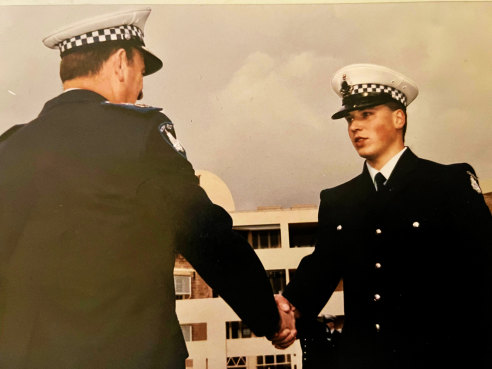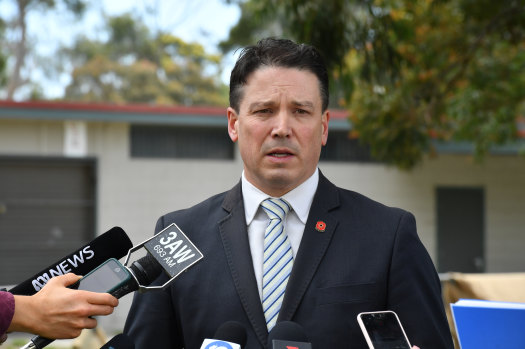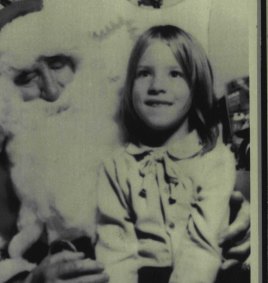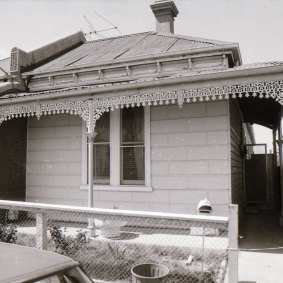- Analysis
- National
- Victoria
- Naked City
This was published 3 months ago
The cop, the career and the cold case that exonerated a mother
The policeman about to front the deputy commissioner had been naive rather than delinquent, but he knew the career that had begun so promisingly may well be over.
When his mate lost control of a car and hit a fire station sign in Kongwak, 130 kilometres from Melbourne in Gippsland, Tim Day stepped in when he shouldn’t have and tried to persuade the two young cops to go easy.
Most times he would have been told to mind his own business, but these local cops saw it differently. Instead of a smack on the wrist for misguided loyalty, he was charged and was facing an internal disciplinary hearing.

Tim Day graduating as a police officer in 1991.
He makes no excuses, saying he should not have treated the two police trying to do their jobs the way he did. “It was my error and I have to own it.”
He was four years into his career, was seen as a natural crook-catcher and had already received an A-rating to become a detective.
A university science student, he joined the force planning to become a forensic scientist. That changed once on the road. “After six months on the truck (divvy van) I knew I wanted to be a detective.”
Day joined the police force in 1991, seven chief commissioners ago, when there were few if any cyber crimes and home invasions were a rarity.
Now his career was on a knife’s edge.
One of his bosses provided evidence urging the panel to give him a second chance. Day was reduced in seniority to the most junior constable in the force and heavily fined.
“I spent 13 months on the pine (assigned to station work).”
While he remained station bound, he would request patrols to pick suspects for him to interview and charge, eventually receiving a district commendation for his work, and restoring his A-rating. He graduated from Detective Training School second in his class.
The story tells you a great deal about Day, who retires this weekend. We are sitting in a coffee shop talking about his career when he volunteers this story that I had not heard before.
In lectures and informal talks with young police, Day tells the story – to help them own their mistakes and learn the lessons of resilience.
It is a sliding-door moment. If the senior cop had not been prepared to give evidence for him and the tribunal was less sympathetic, he would have been lost to policing, and as we shall see, some of our most difficult murder cases would not have been solved.
Superintendent Day has been an outstanding cop, awarded the Australian Police Medal and a Churchill Fellowship to research international homicide investigation techniques. He was part of a review on tactics to investigate violent and organised crime figures, which led to the Viper Taskforce that has made more than 1000 arrests in the last two years.

Tim Day speaks to the media outside a homicide scene in 2019.Credit: Joe Armao
When he was allowed back on the road he was determined to be “the best I could be”, and that meant aiming to be accepted into the homicide squad. He worked there for 14 years in three stints, including as the officer in charge from 2017 to 2021.
First he worked in the clandestine lab division chasing some of the biggest crooks in the state. To catch cunning crooks you need a cunning plan. When they couldn’t find one particular lab, they put a tracking device in a piece of equipment the gang needed to complete the chemical process. It took detectives to the headquarters, carefully set up to make sure it couldn’t be spotted by the police helicopter.
First appointed to homicide in 2001, he was thrown a cold case to get a feel for the job. It was done, not with the expectation of a breakthrough, but to learn the rhythm of murder investigations.
He was handed the case of Bonnie Clarke, a six-year-old girl murdered in her bed in Northcote in 1982.

Murder victim Bonnie Clarke.
The original investigators believed they knew the offender but lacked sufficient evidence. They were horribly wrong.
The victim’s mother, Marion Wishart, had begun a same-sex relationship, leading the initial investigators to conclude she wanted to rid herself of her child to take on a new life.
The back door of the house was unlocked on the night of the murder, and there were two noisy dogs that always barked at strangers. That night the dogs didn’t bark because, police concluded, the dogs knew the killer – or the offender was already in the house.
This supported the wooden-headed theory that it was the mother.
For decades Wishart lived with the grief of her loss – and the anger of being wrongly accused. No wonder she hated police.

Bonnie’s Northcote home.Credit: Fairfax Media
The cold case
They say the answer is in the file – and that is where Day started. Two women who visited the house recalled a lodger who was “creepy” and showed an interest in children.
In the giant murder book there was a reference to a boarder named Mal Clarke who worked in cinemas. Day checked thousands of records of offenders named Clark or Clarke. After 15 hours, he found Joe Clarke, an assistant projectionist.
His full name was Malcolm Joseph Clarke. “I knew then he was the man,” says Day.

Impression of Malcolm Clarke in court.Credit: Bettina Gutheridge
The record showed he had killed Theresa Verity Crowe in her Prahran loft in 1980. He was only charged and convicted when forensically linked to the crime after he raped a neighbour in 1983.
Clarke (not related to Bonnie) boarded at the Northcote house earlier in 1982, which is why he knew the house and why the dogs didn’t bark when he returned to kill.
Day travelled to Wonthaggi to see Bonnie’s mother where she owned a haberdashery shop. It did not go well.
Wishart picked him as a copper. “She threw a sewing machine at me. She thought we were trying to set her up.”
Day, who had been a student at Wonthaggi High, used his local contacts. One of his best friends owned a local pub and told him Wishart popped in on a Friday night for a drink.
For months Day drove from Melbourne every Friday to sit in the pub. “The first time she saw me she walked out.”
Eventually, she went back to her routine. “I would ignore her and never try to engage with her.”
After three months she sat at the seat next to Day saying, “If you are going to stalk me then at least buy me a beer.”
Once onside they needed to eliminate her as a suspect. She agreed to a polygraph test. “She passed with flying colours.”

Marion Wishart in her Wonthaggi home in 2006.Credit: Craig Abraham
The team of cold case investigators wanted a sting operation conducted into Clarke in the hope they could tease out some admissions. After initial resistance the job ran for six months. “He provided details (of Bonnie Clarke’s murder) only the offender could know.”
Trapped, Clarke confessed a second time to Day in the formal interview.
In June 2004, 22 years after the murder and three years after the reinvestigation began, he was found guilty. He was sentenced to 25 years’ jail.
When the jury delivered the verdict, the cop and the mother who had thrown the sewing machine at him sat holding hands. With the word “guilty”, Marion squeezed Day’s hand and said, “thank you”.
Bonnie’s father Denis, who was riddled with terminal cancer, sat on the other side of the policeman. Denis died months later. “I think he hung on to hear that verdict.”

Denis Clarke outside court after his daughter’s killer was sentenced.Credit: Simon O’Dwyer
When Marion died in 2018, Day went to the funeral. “She is without a doubt the bravest person I have ever met.”
While Day is retiring his legacy remains. In 2007, he was selected to head a review of cold case murder investigation methods.
He was part of a team that developed a system to check forensic samples and then review the case before embarking on long costly investigations. This means unsolved murders were given a solvability rating. This stops detectives wasting time on dead-end cases and working on those where there is a chance.
Investigators using that model re-opened the 1977 case of the murders of Suzanne Armstrong and Susan Bartlett. In September police arrested Perry Kouroumblis in Italy and charged him with the murders.
In 2018, Day was awarded a Churchill Fellowship to study international homicide investigations. He returned, recommending a mental health program for homicide investigators and applicants. He also recommended using retired homicide detectives to review cases, and a national investigators’ exchange program.
He found something else. The homicide squad has a greater solution rate than just about any international force, solving murders with fewer resources.
The reason is witnesses are more likely to cooperate, which shows respect for police is not some sort of hypothetical concept. It solves crime.
Day will take a break before exploring career options, but his passion remains.
“I have been constantly amazed at the resilience of the families of murder victims. I just don’t know how they can continue with their lives.”
He says investigations are becoming unnecessarily complex, with new disclosure laws requiring police to gather masses of non-relevant material to give to defence lawyers, which means detectives are spending too much time gathering paperwork and too little solving the crime.
“It is a real concern that government legislation that should protect the public from crime is actually making our job more difficult.
“We could solve just about every homicide if we had the resources.”
John Silvester lifts the lid on Australia’s criminal underworld. Subscribers can sign up to receive his Naked City newsletter every Thursday.